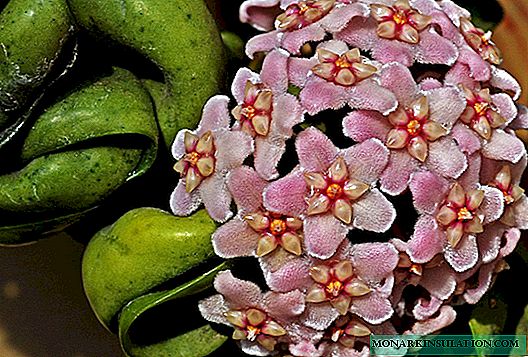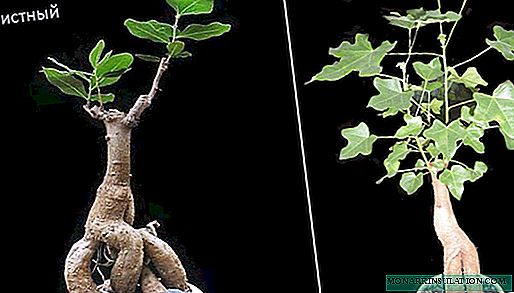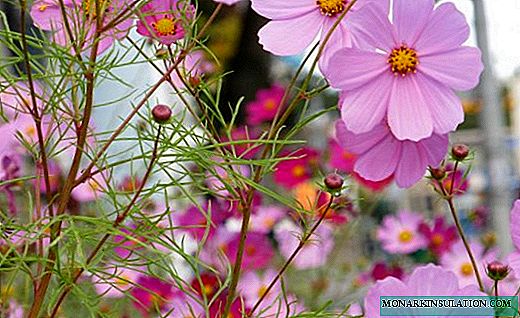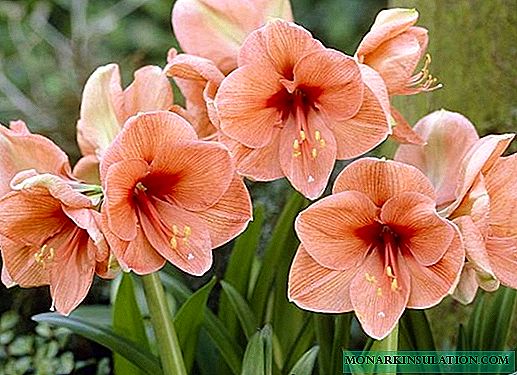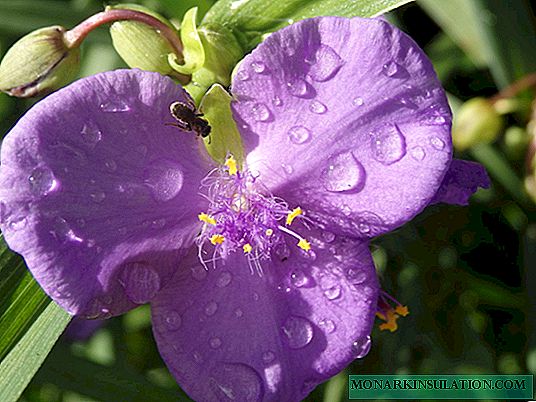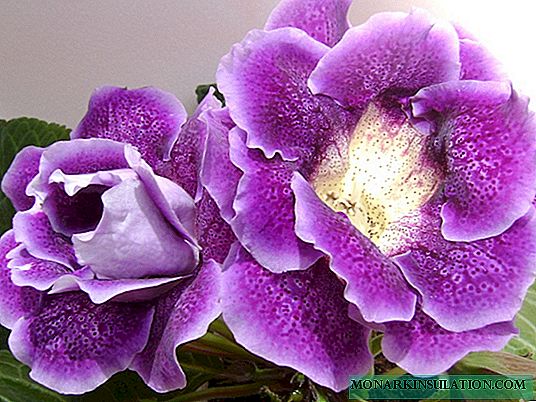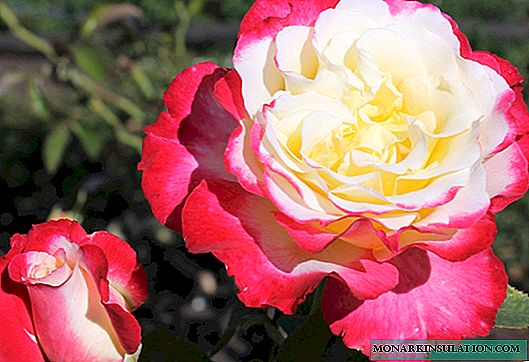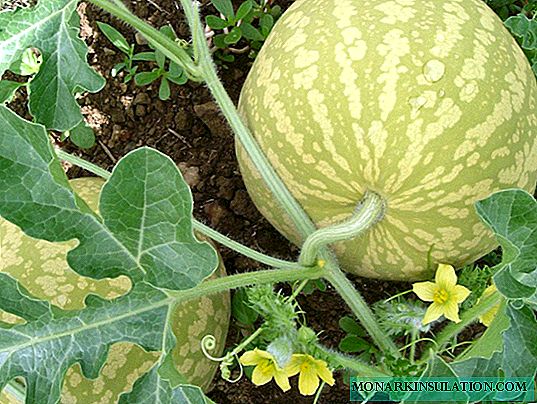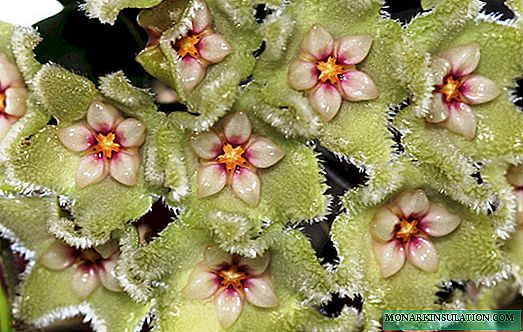
Liana plants organically look in any interior due to their plasticity and versatility. They can be planted in ordinary pots, hanging flower pots, form "green walls", interesting shapes. Hoya also has an “extra bonus” - very elegant flowers-stars of bright shades, effectively contrasting with dark leaves. Caring for a plant at home is even possible for those who do not have much experience in this field.
Hoya: appearance and other salient features
Hoya, also known as “wax ivy,” is a genus of evergreen creepers belonging to the Apocynaceae family. Most of the nearly three hundred of its representatives can be found in Southeast Asia, India, China, on the islands that separate the Indian and Pacific Ocean. Some hoyas look like compact bushes, but this configuration is relatively rare.
The first hoya in 1770 was discovered by the scientists Solender and Banks traveling as part of the James Cook expedition. The name was given to the plant by the Scottish physicist Robert Brown, the creator of the theory of Brownian motion. Thus, he immortalized the memory of his friend, Thomas Hoy, who for many years successfully cultivated tropical plants in the greenhouses and conservatories of the Duke of Northumberland.
In nature, hoya is an epiphytic plant. She lives in forests and undergrowths, using tall trees as a support for her lashes. She does not need anything else from the "master", she is not a parasite. If there is no suitable tree, the vine grows on the ground. On average, it reaches 10 m in length.

Hoya in nature - an epiphyte that uses tree trunks as a support
Hoya flowers collected in dense corymbose or spherical inflorescences look very unusual. They have the shape of regular five-pointed stars with a diameter of 1-2 cm, inside which is located the "crown" - an asterisk of a smaller contrasting shade. The surface of the petals is fleecy, they seem to be cut out of velvet. The color scheme is very wide - from cream to dark purple, which from afar appears black, including various tones of yellow, pink, red, peach and silver-green.

A regular five-pointed star shaped hoya flower may seem artificial
At the same time, more than twenty inflorescences can form on an adult vine. They spread a rich, pleasant aroma, especially intensified at night. The “sweet” smell is associated with marshmallows and caramel. Not everyone likes him, sometimes even causing a persistent migraine. Small droplets of thick translucent substance on the petals are nectar, and not some exotic disease. Each flower lasts 15-20 days.

Inflorescences in the shape of an almost regular ball immediately attract attention
Many gardeners are afraid to start a hoya at home, knowing about the signs and superstitions associated with ivy. Allegedly, the plant "survives" from the house of the dear mistress of men. Even if you believe this, hoya to ivy, which is part of the Araliev family, has absolutely nothing to do.
Feng Shui doctrine, on the contrary, appreciates hoya, considering it a plant, which creates a cozy and comfortable atmosphere in the house, settles quarrels and helps spouses forgive each other's insults. It is recommended to place it in the bedroom. Recently, as a gift for Valentine's Day, "green hearts" have become popular - hoyi wrapped around a support of the corresponding shape.

Hoya organically fits into any interior, here you are limited only by your own imagination
The flowering period stretches from May to October, but the rest of the time the hoya also looks pretty. Young shoots have a chocolate-violet hue; as they grow older they become brown-gray and lignified. The leaves are fleshy, hard to the touch, in the shape of an ellipse with a pointed tip, located opposite. Young people have a characteristic glossy shine, adults - matte. Leaf length - 6-8 cm, width - 3-5 cm. It is because of their texture that the plant received the nickname "wax ivy".

Hoya leaves are also very decorative, but still this is not the main advantage of the plant.
Video: Hoya Description
Views popular with amateur gardeners
Until recently, of the variety at home, only meaty and beautiful hoya was grown. Now much more species are "cultivated" and very interesting breeding hybrids have appeared. Most often in the apartments you can find the following plants:
- Meaty hoya (carnosa). Liana 5-6 m long, needing support for normal development. The leaves are medium-sized, up to 5 cm. Silver-gray strokes and spots on a dark green surface are normal. The flowers are pinkish-white, very fragrant. The plant is unpretentious, tolerates drought without problems, lack of natural light and cool wintering. It became the basis for many breeding hybrids - Crimson Queen (thin beige or pink border on dark green leaves), Tricolor Exotica (bright scarlet flowers, leaves covered with cream and pink stains).
- Miniature Hoya (compacta). Small, as if slightly crumpled or curled leaves with a faint pattern of a lighter shade. A natural hybrid of fleshy hoya. In turn, it became the “parent” of Regalis varieties (white border on lime leaves, changing shade to reddish in bright sun), Mauna Loa (dark green leaves with a yellowish spot in the center).
- Beautiful Hoya (bella), she is lanceolate. Intensively branching shrub with thin, nickel-free shoots. Ideal for ampel growing. Leaves are lanceolate, small (4-5 cm in length). In inflorescence of 7-9 snow-white flowers with a bright purple crown. The plant is thermophilic (even in winter the temperature should not fall below 16-18 ° C), it suffers greatly from overflow. In optimal conditions, blooms all year round.
- Hoya multiflora (multiflora). Liana, in need of support. Leaves with pronounced veins, about 10 cm long, 3-4 cm wide. Light green spots on them are normal. The flowers are pale yellow, spread a pleasant citrus aroma, the "rays" of the inner asterisk are strongly curved outward. Each inflorescence has 30-40 buds. Hybrids - Speckles (leaves with light green spots and ivory flowers), Falling Star (leaves about 15 cm long and petals of a very interesting shape, similar to the comet's tail).
- Hoya is regal, she is majestic (imperialis). Liana with pubescent shoots, petioles and petals. The leaf length is 15–20 cm, the diameter of the dark scarlet flower is 8–10 cm. The “natural” hybrid is the Rausch hoya with bright pink-red petals (this color is known to artists as scarlet). Breeding varieties - Alba (greenish-white flowers), Palwan (yellowish-red), Borneo Red (bright purple).
- Concave or pitted hoya (lacunosa). Well suited for ampel growing. The shoots are brick-colored, leaves 5-7 cm long dark green in the shape of a rhombus. The edges bend slightly inward. The inflorescence is umbrella-shaped. The petals are cream, the crown is yellowish.
- Hoya Kerry Liana with very long lashes. They are recommended to be directed upwards or wrapped around the support so that they do not turn the pot over. The leaf length varies from 5 cm to 15 cm. The flowers are collected in spherical inflorescences of 15-25 pieces. The shade of the petals depends on the quality of the lighting. They can be pinkish, pastel yellow, lemon. An adult plant releases more nectar, which stains them in raspberry, red, chocolate. Hoya Kerry variegata differs from the parent in cream-colored leaves.
- Hoya is pale (acuta). Liana with light green leaves 8-10 cm long and 4 cm wide. Petals pale yellow, scarlet crown. The aroma is very pleasant, unobtrusive, lemon-mint. The flowers are small (1 cm in diameter), collected in umbrella-shaped inflorescences of 40-50 pieces.
- Hoya Shepherd (shepherdii). The leaves are large (12 cm long and 2-3 cm wide), thin, but stiff and shiny. The central vein is highly developed, so they are concave, similar to a boat. Each inflorescence has 12-15 flowers with a diameter of about 1.5 cm. Snow-white petals with pinkish tips, ivory crown.
- Hoya fraternal (fraterna). Pretty capricious, rarely blooms at home. Leaves up to 15 cm long, almost round. The petals are red-pink, the crown is bright yellow.
- Long-leaved hoya (longifolia). Epiphytic shrub. The shoots are thin, the leaves are large (up to 18 cm in length and 1 cm in width), similar to belts. The flowers are small, creamy in color, the crown is dark scarlet. The aroma is mild. The most frost-resistant of the kind.
- Hoya Englera (engleriana). It differs in very small leaves (1.5 cm long and 0.5 cm wide). Flowers with a diameter of 2 cm, pubescent, collected in inflorescences of 4-5 pieces. The petals are white, the crown is lilac red.
- South Hoya (australis), sometimes not quite correctly called Australian. Liana, whose shoots are lignified with age. The average length is about 6 m. The leaves are small, 6-8 cm. The buds are collected in inflorescences of 20-25 pieces. Glossy petals, snow-white with a raspberry base, gradually bend back.
- Hoya linear (linearis). A long vine with thin shoots and pubescent leaves of greenish-gray color. Petioles are very short. Petals are yellowish-cream, fleecy. Flowering occurs at the beginning and mid-autumn. The buds spread the scent of vanilla. Unlike "relatives", he likes plentiful watering.
- Fluffy Hoya (pubicalyx). The stems are long, curly. The leaves are covered with silver spots and strokes. Flowers with a diameter of 1.5-2 cm, last about two weeks. The color of the petals varies from pinkish white to dark purple. There are many breeding hybrids - Red Button, Silver Pink, Chimera, Leenie, Philippines Black and others.
Natural Hoya: varieties in the photo
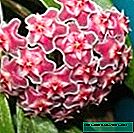
- Fluffy Hoya - the basis of many very spectacular breeding hybrids

- Hoya linear is very moisture-loving

- The flowers on the south hoya last about two weeks, during which time the petals gradually bend back
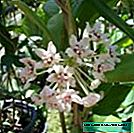
- Hoya Engler has very small leaves

- Long-leaved Hoya can endure the short-term effect of small negative temperatures
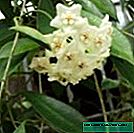
- Blooming Hoya fraternal at home - almost an exclusive sight
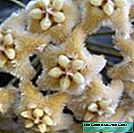
- Shepherd’s petals are densely pubescent
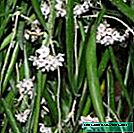
- Pale hoya spreads a very pleasant unobtrusive aroma

- The hue of Kerry's petals varies greatly depending on the lighting.
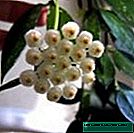
- Concave Hoya stands out against the background of "relatives" with an interesting leaf shape

- The petals of Hoya Rausch are much paler than those of the “parent”

- Royal Hoya owes its name to unusually large flowers with shades of royal purple

- Hoya multiflorous differs in an unusual form of "stars"

- The beautiful Hoya is very well suited for ampel growing

- Hoya miniature - a very interesting spontaneous mutation

- The meaty hoya is one of the first "domesticated" species
Breeding hybrids often look more attractive than “natural” hoya due to larger flowers and variegated leaves.
Photo Gallery: Breeders' Achievements

- Hoya Philippines Black - very unusual and spectacular flowers
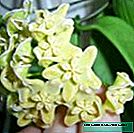
- Hoya Leenie - Petals of a very delicate yellow color

- Hoya Chimera - dark scarlet petals stand out against the background of bright green foliage

- Hoya Silver Pink - crimson lepestki with contrasting silver-white border

- Hoya Red Button - one of the many hybrids derived from the fluffy cup hoya

- Hoya Kerry variegata differs from the “parent” with colorful yellow-green leaves
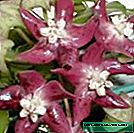
- Borneo Red hoya has rare purple petals

- Hoya Palwan - a combination of pink and peach - like sunset on a tropical island after which the hybrid is named

- Hoya Alba - petals of a very pure whitish color

- Hoya Flowers: Falling Stars are like a comet approaching a star
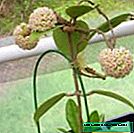
- Hoya Speckles - a very elegant and sleek hybrid

- The color of the spots on the leaves of the mauna loa hoya evokes associations with the moon in Hawaii

- Hoya Regalis - Variegated Variegated Leaves
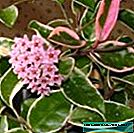
- Hoya Tricolor Exotica - a very spectacular combination of colors
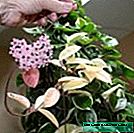
- Hoya Crimson Queen - a popular hybrid, derived from the meaty hoya
How to create a plant optimal microclimate
Creating the optimal microclimate for hoya is not difficult. It is more difficult to maintain these conditions and immediately respond to the slightest manifestations of plant dissatisfaction by regulating temperature, air humidity and lighting.
Table: optimal conditions for growing hoya
| Factor | Recommendations |
| Location | In summer - a window facing east or west, in winter - to the south. After the hoya gains color, it is impossible to mix and rotate the pot - the plant reacts by dropping buds. He is accustomed to any new conditions gradually. The room is regularly ventilated, but you should not take the hoyu out onto the street. |
| Lighting | Bright diffused light shading from direct sunlight. In winter, it will be necessary to illuminate, prolonging daylight hours up to 10-12 hours. Plants with dark green plain leaves feel good in partial shade, which can not be said about the variegated varieties. |
| Temperature | The optimum temperature in the summer is 18-25ºС, in the winter - 15ºС. Long "cold" (10Сº and below) provoke leaf fall. The hoya, the most beautiful, tolerates frosts, it needs an increased winter temperature (about 18ºС). |
| Humidity | It is not a critical indicator, but periodically sprayed hoya develops and blossoms better. Make sure that water does not get on the petals and buds. For sanitary purposes, the leaves are wiped weekly with a wet sponge. |

Hoya is well suited for ampel growing, it is advisable to hang the pots near the window
Correct Hoya Transplant
Hoya does not need annual transplants, although it is growing quite quickly. Those plants that are crowded in a pot bloom more abundantly. One procedure is enough every 2-3 years. If the florist is more interested in lush greenery, on the contrary, you need to transplant the liana every year, acquiring the containers a little "for growth".

If you think that the hoya needs support, place it in a pot well in advance, and not when the plant is already transplanted
It is important that the hoya pot is brand new. Even used containers that were thoroughly washed will not work. The diameter, based on what is more important, greens or flowers, increases by 5-7 or 2-3 cm, respectively.
Khoya is undemanding to the quality of the soil. The soil should be light, neutral or slightly acidic, with good aeration:
- coarse sand, peat crumb, fertile turf, humus (1: 1: 1: 1);
- light loam, leaf humus, garden soil (2: 1: 1);
- soil for orchids and a universal substrate for flowering indoor plants (1: 1).

Khoya is undemanding to the quality of the soil, the universal soil mixture is quite suitable for it
There is nothing complicated in the transplant itself:
- Pour a layer of pebbles or expanded clay on the bottom of the pot 4-5 cm thick. Cover it with a fresh substrate, filling about a quarter of the volume. If necessary, install the support. It is undesirable to use bamboo sticks - they often bend and break under the weight of the green mass, sometimes they rot.
- Water the plant, after 30-40 minutes, remove it from the pot. Try not to destroy the earthball.
- Transfer it to a new container. Add the substrate around the edges. Moisturize moderately. The first 2-3 weeks, be careful with watering and protect the plant from direct sunlight.

Hoya transplant is carried out by transshipment method.
Video: how to transplant hoya
Important Nuances of Plant Care at Home
Hoya is deservedly considered a fairly unpretentious plant, but caring for its various species varies slightly. Therefore, you need to know exactly what kind of variety you are the owner of.
Watering
Hoya is a rather large tropical plant, but it does not tolerate excess moisture categorically. Most species need moderate watering (except for linear).If the leaves of the hoya are dense, similar to succulent, the top layer of the soil should dry by 2-3 cm between treatments. For species with thin, hard or pubescent leaves, the earthen lump is constantly kept in a slightly moist state.
Fertilizer application
Hoya is fed only during the period of active vegetation, from the beginning of spring to mid-autumn. Any complex fertilizer for flowering indoor plants or special products for succulents will do. A nutrient solution is watered twice a month. Nitrogen, potassium, phosphorus and magnesium must be present in the composition. After each procedure, it is advisable to loosen the soil in the pot.

Since the hoya spends a lot of energy on flowering and building green mass, she needs regular feeding
Pruning a flower
The question is whether pruning is necessary, each grower decides for himself. The only rule - in no case do not cut the "stumps" remaining in place of fallen flowers. Next year, it is on them that new buds are formed.
Creeper shoots can be wrapped around supports. When grown by ampel method, they are periodically shortened to the desired length. It is useful in the autumn to cut every third lash about half - flowering will be more plentiful.
Bush-shaped hoyi to pinch branching annually pinch, removing 2-3 upper growth buds on each shoot. The first time the procedure is carried out after the appearance of the fourth leaf. If a crown of a certain configuration is formed, all lashes that violate harmony are cut off.

The hoya arbitrarily growing in different directions looks rather untidy
Bloom
To stimulate flowering, a pot with hoya is dipped in water heated to 30-40 ° C for 2-2.5 hours in late spring and early autumn. Then the substrate needs to be dried well. If you "bathe" the entire plant, reduce the procedure time to 25-30 minutes.

Hoya's flowering abundance often depends on providing a cool winter.
Rest period
Providing the opportunity to "relax" in the winter is the key to abundant flowering for next year. The beginning of the dormant period is indicated by a slowdown in the growth of the vine. This usually happens when daylight hours are shortened.
If there is a backlight, the hoya can do without a winter "rest". Otherwise, the plant needs to provide coolness (if this is not beautiful Hoya), reduce watering and refuse to feed. Moisture deficiency in winter leads to the fact that next year the liana blooms more abundantly.
Common mistakes of a beginner grower
Hoya can bear many mistakes in leaving, but they negatively affect her decorativeness. Clearly signals that the plant is dissatisfied with something, lack of flowering. But there are other "signs" that need to be able to interpret.
Table: how the hoya reacts if it is not properly looked after
| What does the plant look like | What is the reason |
| Lack of flowering. | Warm wintering, excess fertilizer, lack of light, pruning. |
| Yellowing leaves. | High temperature and / or lack of natural light. |
| Falling buds and leaves. | Moving the pot to another place, a sharp change in the conditions of detention, cold drafts. |
| Drying and falling leaves. | High temperature and / or excessively dry indoor air. |
| Leaves covered with dry spots. | Sunburn. The plant was affected by direct sunlight. |
| Leaves covered with blurry light spots. | Deficiency of light or watering with cold hard water. |
| Curling, drying leaves | Unsuitable temperature - too low or too high. |
| Slow growth, pale small leaves. | Lack of fertilizing or the use of unsuitable fertilizers. The most common cause is nitrogen deficiency. |
| The blackening base of the shoots. | Low temperature combined with frequent and heavy watering. |
| Dying shoots. | Stagnant water in a pot. |

The dry leaves of the hoya indicate that the plant is too hot or the air in the room is too dry
Common Diseases and Pests
With proper care and in optimal conditions, the hoya almost never suffers from attacks of pathogenic fungi and insect pests. Problems begin only when the grower forgets about the plant. Simple preventative measures will help minimize the risk of infection:
- quarantine for newly acquired indoor plants;
- inspection of the collection at least once every 5-7 days and immediate isolation of all suspected infected specimens with suspicious symptoms;
- regular airing of the room, cleaning leaves from dust;
- use only disinfected soil, clean dishes and tools;
- compliance with the rules for the care of the plant, especially with regard to watering.
Table: Diseases and Pests that Hoya Affects
| Disease or pest | How does it manifest | How to fight |
| Powdery mildew | A thin layer of whitish plaque on the leaves. Then they lose their tone, turn yellow. |
|
| Root rot | The blackening base of the shoots. The tissues soften, the soil in the pot is covered with a thin layer of mold, a putrid odor appears. |
|
| Shield | Solid brownish tubercles on the leaves, rapidly increasing in volume. The surrounding tissues acquire a red-yellow hue. |
|
| Aphid | Colonies of small yellow-green or black-brown insects clinging to the tops of shoots, the underside of young leaves, buds. |
|
| Whitefly | Small whitish butterflies fluttering from a flower at any touch. |
|
| Spider mite | Thin cobwebs surrounding the leaf petioles and shoots. On the underside of the sheet are small beige dots and blurry light spots. |
|
| Root nematode | Small spherical swellings on the roots, blackness on the cut. The leaves turn yellow, then turn red and become covered with black spots. |
|
Photo Gallery: Hoya-Afflicting Diseases and Pests

- It is possible to accurately verify the presence of a root nematode only if the plant is removed from the pot

- Plants affected by spider mites are treated with special drugs - acaricides
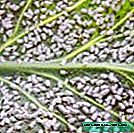
- Whitefly is very partial to yellow; this "addiction" is used in the manufacture of home-made traps
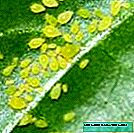
- Aphid is one of the most common pests that feed on the sap of houseplants; hoya is also in its interests.
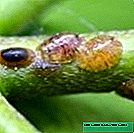
- The durable carapace of the scale shield makes it invulnerable to most folk remedies

- Root rot can be treated only in the early stages of the disease

- Powdery mildew seems to be a harmless coating that is easy to erase, but this disease drains the plant
Methods of reproduction at home
Hoya at home reproduces both in a vegetative and generative way. The easiest option is to root the stalk.
Cuttings
Hoya Shank - the upper part of a semi-lignified shoot 8-10 cm long. It should have 2-3 growth points and several pairs of leaves. The best time for the procedure is early spring or autumn. Flowering will have to wait four years.

Hoya cuttings give roots quite quickly, but to see the flowering, you have to be patient
- Let the cuttings cut dry for 2-3 hours in the open air. Sprinkle the base with any powdery root stimulant (Kornevin, Zircon).
- Drop them in cups filled with a mixture of peat chips and sand (1: 1). Can be rooted in water. In 200 ml, dissolve one tablet of succinic acid and activated carbon. The container is covered with foil, it is pierced with a handle so that only the lower growth point is in the water. Excess leaves are removed.
- Cover the plantings with glass jars or transparent bags. Always keep the substrate slightly moist. Provide a temperature of 20-22ºС and bright light. The roots should appear in 20-25 days.
- Once they form, transplant the cuttings into the soil for adult plants. Otherwise, they will become brittle, will easily break.
- When 3-4 new leaves appear, pinch the hoya to stimulate branching.

Hoya cuttings root more often in the substrate than in water
Video: Hoya propagation by cuttings
Rooting of stem branches
Hoya from stem branches bloom in the year of planting. Thus, plants over five years old multiply.
- On one or more shoots between the growth points with a scalpel or razor blade, make a shallow annular incision.
- Wrap the place with sphagnum moss, previously moistened with a solution of any biostimulator (Epin, potassium humate). Cover with foil or cling film. Securely fasten the entire structure.
- When the roots appear, cut off the top of this shoot and transplant the new plant into a separate pot.

Rooting stem cuttings is the fastest way to get a new flowering plant
Seed germination
The method is used infrequently due to deficiency of seeds, which are almost impossible to obtain at home. On sale, they are extremely rare. For breeding hybrids, the method is generally of little use. Varietal signs of a “parent” are rarely transmitted to “offspring”.

Hoya Seeds - Big Deficit
- Dry the seeds after harvesting for 2-3 months.
- Plant them in a mixture of finely chopped sphagnum moss and universal soil for indoor plants (1: 1).
- Provide the same conditions as germinated cuttings, raising the temperature to 23-25ºС. Shoots will appear in about a week. From this moment, the substrate should be constantly slightly moist, but not wet.
- After about three months, when the seedlings form 3-4 pairs of real leaves, transplant them into the soil for adult plants.

For the prevention of rot, hoya seedlings can be sprayed once a month with a 0.5% solution of any fungicide
Florist reviews
I somehow put the hoya in the sun, I didn’t shadow it. After a while, the leaves turned yellow. I foolishly ripped them off. I didn’t throw it away - I just put it in a glass of water and forgot about them. I was so surprised when I found them again green and with roots. Transplanted into the ground - now I'm waiting for seedlings.
Yolka//forum.bestflowers.ru/t/cherenkovanie-i-ukorenenie-xoji.120171/
The pot needs a little, and replant as it grows. In general, hoya grows well in small containers. Land can be taken for succulents, but I planted in the usual, from the cottage, with the addition of sand and expanded clay. Water as it dries, rarely in the winter, in the summer you can often, you can water it when planting with Kornevin so that it grows faster.
Malinka//forum.bestflowers.ru/t/cherenkovanie-i-ukorenenie-xoji.120171/
My hoya has never bloomed. I read somewhere that it blooms for the 3rd year - here I wait. And here’s what I found. Hoya does not bloom if it is too dark, if last year's flower stalks were cut, if it was wintering at very high temperatures, if there are not enough nutrients in the soil, if the pot is too tight, or the plant has not been transplanted for several years.
Sandmartin//frauflora.ru/viewtopic.php?f=379&t=15433
I think that Hoya does not like heat. I didn’t grow at all on the western window in the summer (I am silent about the flowers), although there are blinds. Even on the leaves, yellow wrinkled spots appeared. She moved to a shelf near the window - she started to grow. My friend, who gave me the cuttings, didn’t have sunny windows.
Ju lee//frauflora.ru/viewtopic.php?f=379&t=15433
Hoya grow jerky. Especially if there was little sun in the summer. In that year, I stood all spring and only at the end of summer began to grow, but did not have time, then the sun was not enough. From March, you can start dressing with complex mineral fertilizers for indoor plants (once every 2-3 weeks). Twice a year (in spring and autumn) the whole plant is immersed in water heated to 30-40 ° C for 30-40 minutes, and an earthen lump for 2 hours. This contributes to better growth and faster flowering. Young plants are transplanted annually, as they develop more intensively in more bulky dishes; adults - every 3 years. The soil is suitable nutritious and easily permeable, slightly acidic and neutral (pH 5.5-7). Hoya grows well in almost any land.
Tatyanka//flowrum.ru/threads/hoji.469/page-7
Cut into 2-3 internodes, may not pull more, the top will dry! Put the cuttings in boiled water, add a tablet of activated carbon, you can still a little Kornevin! Hoya very well takes root in the water, but, most importantly, do not overexpose it there! When the roots are about 1 cm in length, transplant into the ground. Yes, even watering should be moderate, because it is a succulent vine, after the soil has completely dried.
Fedora//www.orhidei.org/forum/79-974-1
I once had a hoya. For a long time she sat still, did not grow. As it turned out later, it was dark for her. She hung on the wall. And I moved it to the window. And since we had a south side, a sun car and a small cart, she really liked it. Started up sharply. Gradually, it grew into an entire window. I pulled the strings around the window and wrapped them around the hoya. The flowers were very beautiful. The pinkish stars with a red center, gathered in umbrellas, really seemed waxy. And also droplets on them. But it came to the point that in the summer on it there were simultaneously 20 or more outlets with flowers. And dad was choking on this scent at night. Of course, we weren’t so stuffy from them, but having regretted dad, I had to throw her out.
Zefirka//www.floralworld.ru/forum/index.php?topic=92.0
In order for the hoya to bloom well, you need a large amount of light, which is better than scattered in the summer. And preferably a suitable temperature during rest. In the autumn-winter period, the temperature is not lower than 16 ° C (the exception is carnosa, it is kept in winter at 12-14 ° C).
Asio otis//www.floralworld.ru/forum/index.php?topic=92.0
It seems that the hoya for flowering just needs good lighting. Carnose's parents bloomed for a very long time and abundantly. And she stood on the south window, in the kitchen. In winter, of course, there was no talk of any cool wintering, but it bloomed perfectly. But the sister already has a hefty liana, beautiful dark green leaves, but she is not going to bloom - she has all the windows to the north. In short, the sun and hoya are best friends. In addition, in order to stimulate flowering, they bathe her in a warm bath, and along with the soil.Twice a year (in autumn and spring), they dip with the pot for 2 hours in a warm bath.
Xeniya//www.floralworld.ru/forum/index.php?topic=92.0
Hoya owes its popularity among lovers of indoor plants to the unpretentiousness and beauty of flowering. Small "stars" collected in dense balls or shields look very impressive. Do not be afraid of superstitions associated with wax ivy. Feel free to plant this unusual vine. The only real obstacle is pollen allergy.







































